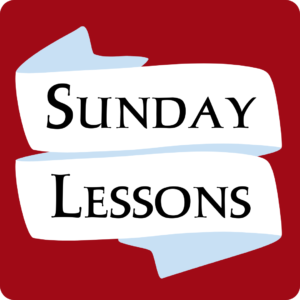Worship Guide for April 27, 2025
Like TV Guide, but from God! Find the text of the Prayers of the People and Sermon below. Use the buttons provided to find other worship materials.
To see the Worship Guide for other weeks, click here.
To see the Book of Common Prayer online, click here.
Prayers
Weekly Prayer List Recording:
Prayers of the People:
Prayers of the People
The response to the bidding, “Lord, hear us”, is “Lord Graciously hear us.”
Father, we praise you for the resurrection of your Son Jesus Christ from the dead. She his glorious light on all Christian people, that we may live as those who believe I the triumph of the cross.
Lord, hear us: Lord graciously hear us.
We pray for those who at this season are receiving in baptism your Son’s new life by water and the Spirit. Dying with Christ, may they know the power of his resurrection.
Lord, hear us: Lord graciously hear us.
We pray for all whom we know and love, both near and far; especially those whose birthdays were last week: Maya Fenn, James Munro, Cheryl Bishkoff, and Malcolm Griggs; and whose birthdays are celebrated this week: Mark DiPetrillo, Karen Bracken, and Mary Porter. May their eyes be opened to see the glory of the Lord.
Lord, hear us: Lord graciously hear us.
We pray for those who suffer pain and anguish, especially those who have asked for our prayers, including Mary, Sam, Benjamin, Hugh, Steve, Cathy, and those we name [pause] Grant them the faith to reach out towards the healing wounds of Christ and be filled with his peace.
Lord, hear us: Lord graciously hear us.
We remember before you those who have died in the hope of the resurrection, especially Pope Francis, and those we name [pause] Unite us with them in your undying love.
Lord, hear us: Lord graciously hear us.
Join our voices, we pray, Lord our God, to the songs of all your saints in proclaiming that you give us the victory through Jesus Christ our Lord.
Lord, hear us: Lord graciously hear us.
Celebrant adds a concluding prayer
Sermon
The Razed Terrain of What Remains
K Casenhiser
Second Sunday of Easteer
Year C
Acts 5:27-32
Revelation 1:4-8
John 20:19-31
Sermon Recording:
This week, we sink into what remains after Easter. We might ask questions like: What parts of Holy Saturday remain with us after the resurrection? In the quiet days that follow Easter Sunday, I find I have more conversations about grief than I do about joy. The overwhelming weight of mourning is still present in this post-resurrection Eastertide, which seems a paradox given the season’s brightness. As is my custom, I spent most of Holy Monday checking in with friends about their Holy Week experiences. One friend asked: “Are you still in the tomb or are you rising? I replied: “In between with Magdalene in the garden next to the tomb, of course.” You? “Grieving with them disciples and ready for a nap,” he said. Another friend expressed her frustration with being pummeled by a chorus of brass at their Easter services. After probing a bit, she said, “My spirit was not ready for the celebratory sound of trumpets. You know?” This sentiment made me especially grateful for our oboist, Cheryl, whose instrument seemed to capture Easter’s ache and glory so fittingly.
My friend’s remark about Easter’s unbidden “brassiness” brought to mind the song “There Won’t Be Trumpets” from Anyone Can Whistle, a piece I often contemplate in these tender early days of Eastertide. The lyrics speak of how Love breaks in quietly and plainly: “There won’t be trumpets or bolts of fire to say he’s coming. No Roman candles, no angel’s choir, no sound of distant drumming. Don’t look for trumpets or whistles tooting to guarantee him! There won’t be trumpets, but sure as shooting, you’ll know him when you see him!”
Without whistles, without drums, Love comes in our midst to be recognized through what it does. Moreover, what does Love do? Love comes again and again and speaks, “Peace, I bring you. Peace I leave you.” This song resonates with me because my first alleluia always tremors in the light of the Paschal candle. I enter Easter trembling, where we find the disciples today.
Mercifully, God does not wait to appear to us until we have resolved the paradoxes of what life looks like after death. The opening lines of today’s Gospel set us in time: “When it was evening on that day, the first day of the week.” This phrase signals to hearers that this post-resurrection encounter was not the first one that day. By contrast, it was the fifth. Reading across Gospel accounts, we find that this encounter with the disciples at table in the locked room followed four others that day: first with Mary Magdalene in the garden (John 20:11-18).; then Jesus appears to the other women (Matthew 28:9-10); then to the two on the road to Emmaus (Mark 16:12-13, Luke 24:13-32), to Peter (Luke 24:33-35), and then to the ten disciples gathered this evening (Luke 24:33-35). It strengthens our faith to attend to what remains unresolved within us and around us. It is for our benefit not to rush. Integrating the Passion’s whole arc into a post-resurrection life of faith takes time. What is faith except trusting in what we cannot yet understand? If we could resolve all the tensions of the Passion and the paradoxes Easter leaves us with, we would falsely assume practicing a life of faith depends upon what we can do. Furthermore, that would miss the point because the resurrection reminds us that God does exactly what we imagine to be impossible and will keep doing these impossible acts even when we disbelieve. These post-resurrection vignettes remind us that resurrection is not a single event but an ongoing process.
The Christ we encounter after the Passion invites us to a transformed life shaped by death’s impact. This is not just about individual life but about the continuous work of being the Church. Recognizing Christ’s presence after the resurrection and understanding how the Passion has marked us is a journey. Our texts for today remind us that God, not our efforts, makes belief possible again after death. Trusting Christ in this post-Passion reality is a process, especially given Christ’s promise of God’s presence alongside the eventual, further transformation and departure of Christ. The post-resurrection accounts, like the story of Thomas, place us in the same paradoxical space Mark left us in on Easter: suspended between belief and unbelief, reaching for something to hold. We find ourselves tentatively grasping at what it means to live well. If you have ever rock climbed, you know that fingerholds are not meant for permanent support; they are points of transition, aiding ascent or descent to what lies beyond. As we consider our suspension, hands gripping these fingerholds, we might ask what courage calls us to do now. It is worth recalling Mark’s insight from last week: belief is neither a possession to be grasped nor something that can be entirely lost, even amidst profound change. Why? Because we do not fasten belief. Belief is not about our actions but God’s faithfulness to keep showing up.
In these post-resurrection stories, God actively helps God’s loved ones see and believe anew. With Mary, who initially mistakes the resurrected Christ for a gardener, recognition comes when Christ calls her name. The grieving disciples on the road to Emmaus encounter Christ in the familiar comfort of breaking bread. Moreover, later, Christ appears to the fearful, locked-away disciples, offering the simple yet profound gift of peace: “Peace be with you.” This peace, Christ seems to remind us, comes from God. Any belief, or pistis in Greek, that we experience originates from God and the work of the Holy Spirit, breathed into us so that we might truly live, even after death. We do not need to cling to a belief desperately if this is true. Like the disciples, like Thomas and Mary Magdalene before them, we can release our grip on the fingerhold and attempt to believe without immediate evidence. Here, I imagine God as the harness supporting us as we climb. In these post-resurrection encounters, we see an incarnate God who continues to reveal Himself, even in changed forms. Perhaps God is showing us that stumbling with our doubt is okay. God will keep appearing, offering the solace we need to unlock the self-imposed barriers of grief, fear, and disbelief, so that we can continue the work entrusted to us. Unlocking those doors requires trust, at least a measure, because we often see our defenses as protection against the world’s harshness. Nevertheless, Christ comes as the door itself, saying, “Peace be with you.”
As theologian Andrew McGowan noted in his substack last week: “The Easter story is told as one that forces the characters themselves to reinterpret their world, and to relearn who they are and who Jesus is. Some of this is about the future, but some remember what he had done and said in that Galilean past. For the reader, the Easter message is, by implication, one in which we both view the past differently and also face the future with the possibility that the world is one in which stones may just have moved, and where those once thought dead can be sought among the living.”
We know this instinct to hide when we are still raw from grief and processing, don’t we? When the air feels thick with uncertainty and the shape of strange absence, when mourning is still caught in our throats, our human inclination is to retreat, bolt the doors, and turn inward towards the perceived safety of our fortifications. We become fixated on the false fingerhold of the protections we can erect, and the great, often perilous, mission to which we are called can fade into the background, a distant and unsettling whisper.
Nevertheless, much the way faith endures despite us as an enduring imprint, the promise Christ brings as the bearer of incarnate peace is this: our locked doors, the barriers we erect out of fear and anxiety, cannot contain the transformative presence of Jesus. Just as he appeared to those first bewildered disciples, amidst the whirlpool of their fear, pain, doubt, and utter confusion, so too does Christ come to us. Christ steps into the heart of our unease, offering not condemnation, but peace. Christ offers an alternative narrative of ongoing presence after death. The peace Christ gives is his Spirit. “And then, Christ breathed on them, breathing life into our anxious existence. The same breath of the Holy Spirit, the divine life force, initially animated and sustained the world.
Last week, Mark spoke of belief not as possessing doctrinal propositions, but as a heartfelt experience of being imprinted by a story. Here, Thomas’s confession echoes that sentiment. This is visceral recognition. Consider Thomas’s powerful confession. John imagines Thomas speaking with the possessive adjective “my”. Rather than saying “The Lord and God,” Thomas says: “My Lord and my God.” This is not an abstract intellectual statement, but rather, a profound claim of renewed relationship, a reminder that relationship with Christ continues after death.
And what should we make of Thomas’s request to see and touch Christ’s wounds? What can we learn about grief from his asking to touch the body of Christ again to grasp the profound truth of John 1:14?. As our text suggests, there is a sense that Thomas’s very request brings the entire Gospel narrative full circle. His ultimate confession, born not of sight but of encounter, takes us back to the very genesis of John’s powerful prologue: “In the beginning was the Word, and the Word was with God, and the Word was God… And the Word became flesh and dwelt among us.”1 In a way, Thomas asks to see that Christ still dwells among us.
In this profound moment of recognition, we are reminded that for John, the incarnation, the Passion, the resurrection, and the ascension are not disparate events; they are woven as one narrative, in one body. Here, in these post-resurrection vignettes, the Word is being made flesh again, the Divine is breaking into the human again. This incarnational story of God with Us is a narrative that continues to imprint upon our understanding of what it means to be crushingly human and infinitely beloved by God.
Choosing a credible storyline this Eastertide means acknowledging the grief and uncertainty that may linger within us. It means recognizing that we do not celebrate resurrection as an isolated event. Resurrection is a narrative encounter that includes everything that came before and anticipates everything that will come after, as our text from Revelation does. As we engage with the narrative of resurrection, it keeps making meaning of our lives and walks of faith. When we assent to the ongoing process of reinterpretation, with Mary Magdalene, Peter, the disciples, and Thomas, we loosen our finger hold and lean into the relational, gradual unfolding of God’s liberating love in our lives and the world. Embracing the messy, tenuous journey of faith in life after death is vulnerable. Still, integrating Holy Saturday into Easter Sunday is the only way because life includes death. We need a theology of resurrection that recognizes death’s ongoingness even as life breaks into it.
Here, theologian Shelly Rambo’s scholarship on trauma and the pneumatology of the Holy Spirit, as the one who witnesses what remains after death, offers a powerful lens on what it means to practice Love inside of resurrected life. In Spirit and Trauma, she writes, “The presence of the Spirit is more fragile and unrecognizable in the middle space. It is a divine presence marked by absence. Forsakenness, abandonment, and alienation are truths of the cross that remain, extending beyond death to transform the landscape of life. The question for Christian theology is this: is this remainder a threat to proclamations of resurrection, or is this remainder the seeds of witness upon which all resurrection claims must be grounded?” (Rambo, 2010).
If resurrection is grounded not in what has passed, but in what remains, that gives hearers of this story permission not to erase the trauma of Good Friday, instead to journey into its “aftermath” with faith that God remains with us as we do. Acknowledging the “ongoingness of death” after resurrection is critical to give a complete account for the weight of the Passion and to faithfully attend to how such events necessarily transform those who witness them. Christ does not exit the Passion the same, and neither should we. In this post-resurrection landscape, we are invited to the holy work of grappling with what life looks like while burial clothes are still hanging off of us and lament is still on our lips.
Rambo describes the perennial task of theology as integrating trauma rather than skirting it for a more one-dimensional narrative. “Trauma,” she says, “forces us beyond a familiar theological paradigm of life and death, and places us on the razed terrain of what remains. Trauma presses theologians to seek new language to express God’s relationship to the world” (Rambo, 2010). And finding this new post-resurrection language is the work of the Holy Spirit because when Christ descends to Hades and ascends again to be with the Father in Heaven, the Holy Spirit remains in the messy middle with us.
Rambo’s theology of the Holy Spirit as the one who remains through death and all its aftershocks, invites followers of the risen Christ, who appears to us still wounded, to “forge a path of healing amid all of the complexities” by recognizing that the resurrection is not a static act; to resurrect is a verb and a process that changes our relationship to ourselves, to God, and one another. It is a process of “witnessing to what does not go away, to what remains”, a process that demands a “theology of witness in which we cannot assume presence or straightforward reception of a violent event but, instead, contend with excess of violence and its tenuous reception”
This Easter, may we not rush to a premature hallelujah, but embrace the messy middle where death haunts life, resurrection unfolds in the tremors of our hearts, and the Spirit remains and calls us out to do the work of witness in the world. May we, like the disciples, grapple with the paradox of faith and doubt, knowing that God meets us not in resolvable answers, but in the tenacious persistence of Love whose life-enacting Spirit remains with us. Amen.





